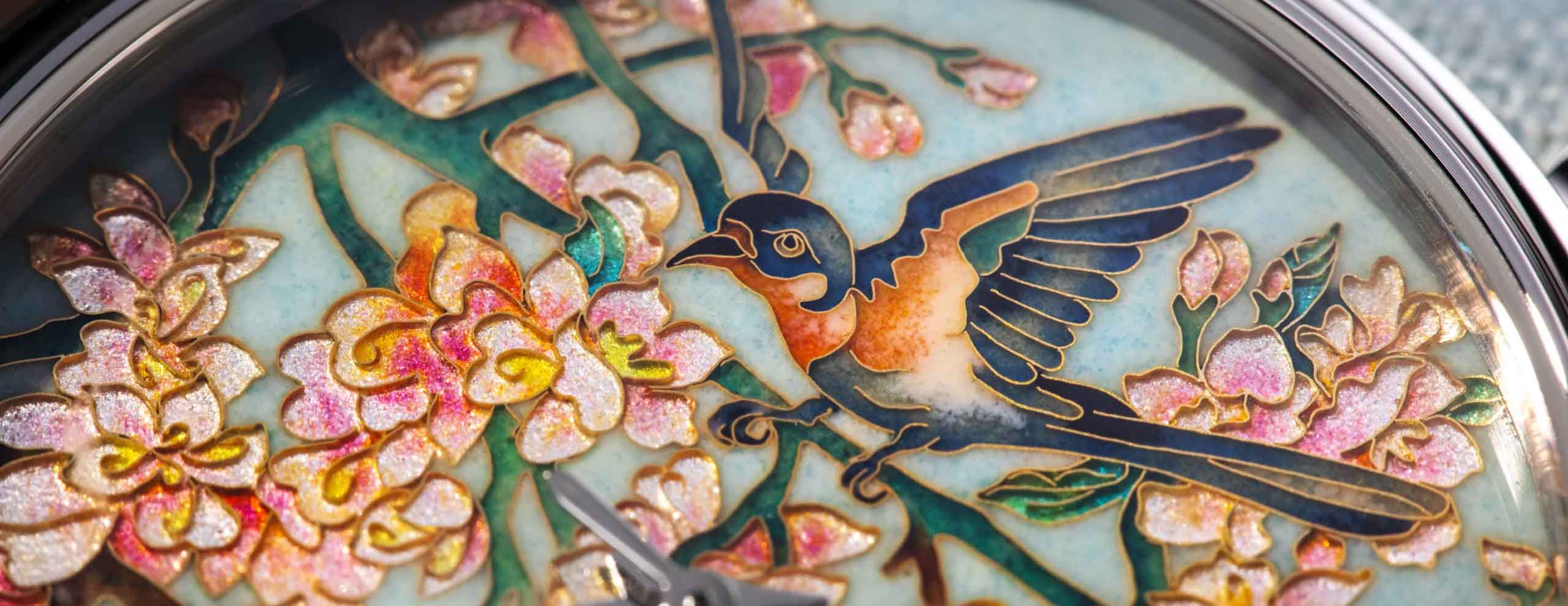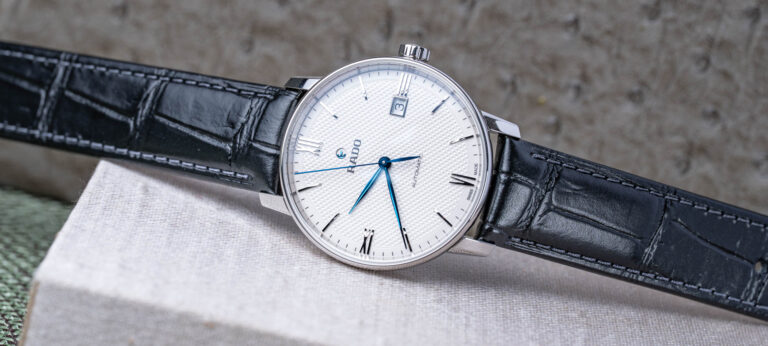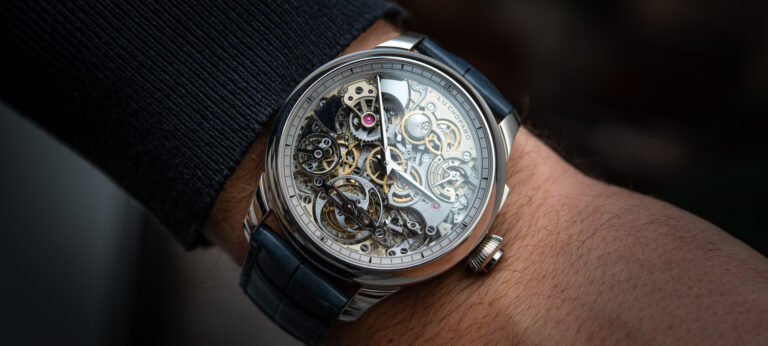China has one of the world’s most enduring and richly layered artistic traditions, capturing both imagination and reality through visual expression. From early images carved on oracle bones and cast into bronze vessels, to the refined brushwork on silk and paper, Chinese painting has conveyed not only the physical world but also the philosophical and poetic sides of life.
Like many ancient civilizations, China began depicting its surroundings thousands of years ago. What makes it distinctive, however, is the unbroken evolution of its techniques, aesthetics, and cultural meaning. Across dynasties, painting in China has remained a living tradition, reimagined in every era with new layers of meaning, yet always rooted in its core values of harmony and balance.
Did China have its own tradition of enamel watchmaking?
This tradition lived not only in the halls of scholars but also in the rhythm of everyday life. Painting and calligraphy adorned walls, furniture, dining wares, and the most ordinary household objects. These were never regarded as merely useful. They were made to carry beauty, stories, and craftsmanship. Walk through a historic town or browse a book on Chinese culture, and it is clear how deeply art is woven into daily life. This blending of craft and living reflects a central idea in Chinese aesthetics: beauty belongs in the spaces where life unfolds. The writing desk, the dining table, even the curve of a teacup became places for expression. Art was never distant or abstract; it was a constant presence shaping how people experience the world.

An exquisite cloisonné clock from the Qing Qianlong period, made in-house by the imperial court workshop. Standing 1.22 m tall and 49 cm wide, the enamelled vase features flowers that open to reveal figurines inside, and ducks that move to simulate swimming. (Image: The Palace Museum)
Perhaps most fascinating of all, Chinese artistry was not limited to brush and ink. It also extended into porcelain, where painting was fused with firing techniques to create works that endure through the ages. Unlike works on paper, these creations withstand moisture, shifting temperatures, and the wear of time. This blend of technical mastery and artistic vision not only brought China renown for its porcelain but also gave rise to exquisite enamelware. These objects traveled far beyond China’s borders, enchanting collectors abroad and inspiring other cultures to develop their own vivid and ornate ceramic traditions.
For watch enthusiasts, porcelain and enamelware may be the most intriguing of China’s many painting mediums. With such a long history of mastery in these crafts, it is natural to wonder whether that same artistry ever found its way into watchmaking. The Swiss are well known for their enamel dials — but what about the Chinese?

A modern enamel wristwatch by Celadon HH, with the dial executed by Xiong Enamel. (Image: Revolution ©)
The truth is that Chinese watchmakers also have a deep tradition in enameling. This heritage came back into focus in the 1990s, when collectors began seeking out decorative pocket watches from earlier centuries. Many of these pieces, made especially for the Chinese market, began appearing at international auctions. They were valued not only for their mechanics but also for their artistry and cultural meaning.
Even Chinese emperors were drawn to such creations. Influential in setting the country’s artistic direction, they established watchmaking workshops within the palace and gathered master craftsmen to produce pocket watches and clocks decorated with enamel and intricate ornamentation.
That legacy is still alive today. It continues to inspire a new generation of Chinese brands now coming to the fore. In the next section, we look at five contemporary makers who carry this tradition forward, creating enamel-dial watches of real quality, many still within reach for collectors. They include historic local names such as Beijing Watch, as well as newer up-and-coming brands like Langle Yuan. We also highlight dedicated workshops that focus entirely on enamel watches and supply enamel dials to others.
Beijing Watch
Founded in 1958 by the government, Beijing Watch Factory has been a backbone of Chinese watchmaking since the mid-20th century. Over the decades, it has built a reputation that stretches from producing reliable everyday watches for the mass market to crafting top-tier pieces with complications such as tourbillons and minute repeaters.
The same philosophy carries into its enamel-dial creations: there is something for every budget. Beijing Watch entered this field with a bold statement in 2007, when it collaborated with Xiong Enamel on its very first enamel timepiece. The debut watch, poetically named Butterflies in Love with Flowers after a Song dynasty verse, was a tourbillon with both an enamel dial and enamel movement bridges on the back. Limited to just three pieces, it was unveiled at Baselworld 2007 and marked a spectacular entry into enamel artistry.
Since then, Beijing Watch has produced a range of high-end enamel watches, many open to customization, while also offering simpler time-only models with a surprising variety of enamel dials, including enamel on guilloché and even cloisonné enamel, that are priced under USD 3,000. These accessible pieces give newcomers a clear path into the world of enamel watchmaking.

The solid gold A Deer of Nine Colours limited edition, inspired by Dunhuang murals and executed by Xiong Songtao of the Xiong Enamel workshop. (Image: Beijing Watch)
Tan Zehua
While there are still major names such as Seagull and Fiyta producing enamel dials, our attention here turns to the independent scene. Among its pioneers is Tan Zehua, a watchmaker with a particular devotion to enamel.
Born in 1953 into a family of watchmakers, Tan spent decades in factory work before opening his own clock-repair workshop. Only later did he strike out on his own as an independent. Unlike others who rely on purchased movements, Tan designs his own, blending lessons from vintage construction with inspiration from leading contemporary masters. His calibres are finished to a high standard, and he has even developed a patented escapement known as the Di-Axial.
That same dedication extends to enamel. Many of his time-only watches feature miniature enamel paintings, created in collaboration with the respected Koncise workshop, which we will explore in more detail shortly.
Xiong Enamel
There are two specialist workshops in China dedicated to enamel dials (not to be confused with the many others producing vases and decorative objects), and Xiong Enamel is one of them. Founded by Xiong Songtao in 2008, the workshop continues a lineage spanning three generations. His grandfather worked in the royal cloisonné enamel, or Jingtailan, workshop, while his father established what became the largest Jingtailan factory in Beijing. Today, Xiong has shifted the focus to miniature enamelling for jewellery and watches.
Located in southeast Beijing, Xiong Enamel operates out of a farmhouse that has been converted into a workshop. The setting is simple, but the output is anything but. The workshop is skilled in three techniques: champlevé, cloisonné, and miniature enamel painting, with cloisonné as its signature. Xiong’s cloisonné is distinguished by the remarkable fineness of its wires, which can be as thin as 0.04 millimetres. For comparison, Patek Philippe states on its own website that its cloisonné wires measure less than 0.5 millimetres in thickness, making Xiong’s nearly ten times finer.
Using both gold and silver wire, Xiong’s cloisonné work has been showcased in commissions from major brands, including Butterflies in Love with Flowers by Beijing Watch and the Shenzhou series by Fiyta. Miniature enamel painting is another specialty. For his own wedding, Xiong even commissioned a pair of watches from Beijing Watch and personally painted the dials as gifts for himself and his wife.
According to interviews, the workshop produces only about one cloisonné or miniature enamel dial every two months, each requiring 15 to 20 firings. Champlevé enamel, however, allows for greater output. By engraving the base by machine before applying enamel by hand, the workshop is able to make between 30 and 50 dials a month.

The workshop also produces other enamel pieces, from fine jewellery to large vases, but this water pot stood out. Once used by scholars to dilute ink for calligraphy, it is rarely seen today, and the Chinese ground orchid on stone is executed with remarkable detail and restraint. (Image: Shoushi Gonghe)

A trio of Celadon Century CH 5 watches featuring enamel dials executed by Xiong Enamel. (Image: Independent Watcher)
Koncise
Another major enamel dial workshop in China is Koncise, whose work many collectors may already know. The company produces both high-end enamel dials and more accessible ones, such as those made for Atelier Wen. Unlike Xiong Enamel, Koncise does not have a long family lineage to rely on. It was founded from scratch by Kong Lingjun, who believed China was capable of producing wristwatches on par with the Swiss.
Kong devoted years of effort and millions of dollars to both watch component manufacturing and enamelling. Today, Koncise stands not only as a leading enamel dial maker and supplier, but also as a watch brand in its own right, producing only enamel watches.
A key part of this success comes from the expertise Kong was able to bring in. He convinced two veteran masters from the Beijing Enamel Factory, an institution founded in 1956 through the merger of dozens of private workshops and a former royal atelier, to join him. With more than three to five decades of experience in cloisonné enamel, they laid the foundation for Koncise’s standards.
Equally remarkable is Koncise’s approach to hiring. Kong has made social responsibility central to the business, employing people with disabilities. Of nearly 100 staff, more than 90 percent have hearing or physical impairments, with the exception of their hands, which are trained to produce enamel dials of exceptional quality.
That quality has not gone unnoticed. Two of Koncise’s pieces have been acquired by the Musée international d’horlogerie in Switzerland, and others are held in the collections of the Rockefeller family and Hong Kong business magnate Li Ka-shing. Most recently, Koncise became the official partner of the Palace Museum in Beijing, a recognition that highlights its cultural importance and international standing.

The latest from Koncise features a beautiful depiction of lotus in a Chinese ink painting style. The case is finished in a luxurious yet understated manner that complements the dial well. (Image: Koncise)
Langle Yuan
With the spotlight often falling on the larger workshops, it is worth turning to a younger independent name: Langle Yuan, founded by a Gen Z watchmaker. Still a niche brand, its appeal lies in the quality of its enamel work paired with restrained design, which speaks volumes about the thought behind each piece.

The depth and magnificence of the Matterhorn are beautifully captured in this enamel dial, inspired by the watchmaker’s visit to Switzerland. The logo is subtly engraved at 10 o’clock, then filled and polished. (Image: Ctime)
The brand is also notably particular about its enamel paste. Countless trials are made before settling on the right tone, and the results speak for themselves. The colours are rich yet never overwhelming, carrying a soothing, natural presence. It is a feat of balance: the work does not flaunt technique but instead reflects restraint and a layered complexity.
What may surprise readers most is the accessibility. Time-only models with cloisonné and miniature enamel painting are priced at around USD 1,500. These are not just conventional enamel dials either. The watches feature a clever time display through a fan-shaped aperture that integrates seamlessly into the dial, offering a more poetic alternative to the standard hour and minute hands. The movement beneath is based on Sellita.
For those seeking something more ambitious, the brand also produces high-end models with tourbillons, proving that even a newcomer can deliver both charm and technical depth.
Bonus round: Celadon HH
China’s watchmaking landscape is rich with talent. From enamelling to engraving to miniature painting, the country has a deep pool of skilled specialists, supported by long traditions in enamel, porcelain, clay, and painting. It is no surprise, then, that the environment is ripe for collaboration, where independent brands or individuals can work directly with artisans to bring unique ideas to life. I have enjoyed doing this myself, commissioning Yixing clay teapots and cups engraved with adaptations of historical paintings I admire. The same practice extends to watches, where collectors occasionally commission one-off enamel pieces. Among the finest examples of this approach is Celadon HH.

The Summer Bamboo piece from the latest Imperial Four Nobles collection by Celadon HH. (Image: Revolution ©)
Though not widely known, Celadon HH is based in Singapore. The brand has built its reputation by commissioning work from independent watchmakers such as Lin Yonghua and Andersen Genève, as well as from enamel specialists like Xiong Enamel. Over the years, its releases have grown more refined, each showing greater assurance and depth. The latest, the Imperial Four Nobles, captures Chinese aesthetics in a way that feels both natural and authentic. From the themes to layout and colour palette, the watches reflect a distinctly Chinese sensibility without leaning on European references and arguably even surpasses certain domestic makers.











